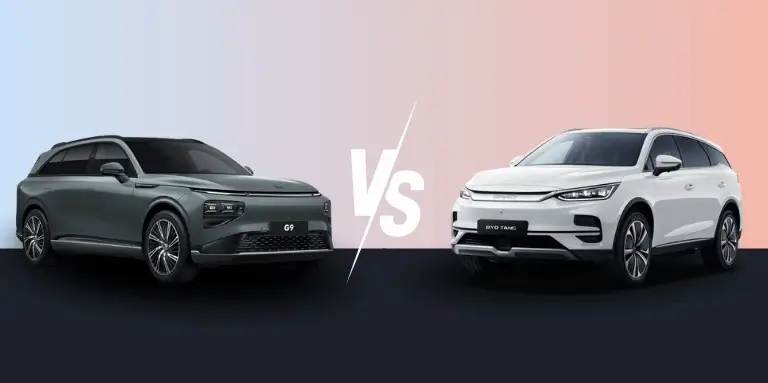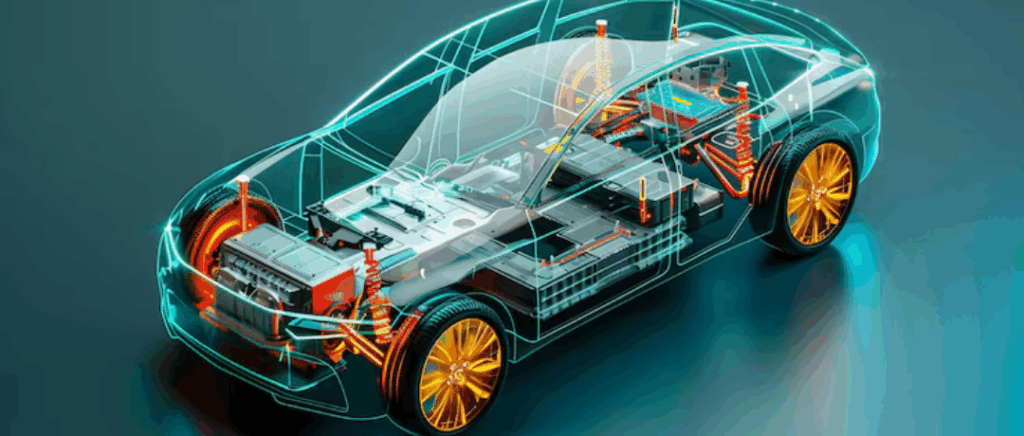Performance and driving: XPENG G9 or BYD Tang, who's got the edge?
How does the 551-hp XPENG G9 measure up on the road?
Le XPENG G9 has become a benchmark for performance and technology thanks to its latest-generation X-EEA 3.0 platform. This architecture, entirely dedicated to electric vehicles, incorporates state-of-the-art IT centralisation and ultra-fast communication via Ethernet, enabling optimum symbiosis between the hardware, software and multiple driving assistants. The G9 takes advantage of these advances to deliver 551 bhp (405 kW) and 717 Nm of torque, with lightning acceleration from 0 to 100 km/h in 3.9 seconds. This dynamic performance puts the SUV XPENG G9 is on a par with the best premium models on the market when it comes to driving sensations, thanks above all to its all-wheel drive system, which offers exemplary traction at all times.
Roadholding is enhanced by a chassis equipped with a suspension system with double wishbones at the front and multi-link rearThe X-EEA 3.0 architecture also facilitates the integration of advanced power assist systems (XPILOT 4.0). The X-EEA 3.0 architecture also facilitates the integration of advanced assistance systems (XPILOT 4.0), and intelligent power management ensures that thrust is always fluid, precise and instantaneous. Braking, in keeping with the power available, remains powerful and progressive, making the G9 as reassuring as it is effective, even in the most dynamic situations.
Is the BYD Tang powerful enough for a professional fleet?
Le BYD Tang is based on the e-Platform 3.0developed exclusively for electric vehicles and designed to offer robustness, efficiency and modularity. This technical base houses an all-wheel drive system and two electric motors combining 517 horses and 680 Nm torque, enabling acceleration from 0 to 100 km/h in just 4.9 seconds. This architecture guarantees crisp acceleration and optimum traction, whether the vehicle is laden with passengers or equipment, making the Tang as capable in urban areas as it is on the motorway.
Suitable for intensive professional use, the Tang features an efficient braking system equipped with Brembo callipers, with a stopping distance of 36 metres from 100 to 0 km/h, and a chassis designed to offer stability and control even when manoeuvring quickly or under heavy load. Precise steering, combined with battery electronic safety assistants and driving dynamics, for a calm and reassuring experience on every journey. Thanks to its platform, the BYD Tang is a high-performance, reliable solution for companies looking to combine power, safety and versatility in their fleets.
Autonomy and recharging: which electric SUV has the longest life?
What is the real battery life for the XPENG G9 in mixed use?
In real-life conditions and in mixed use (alternating between town, country roads and motorway), the XPENG G9 boasts a range of between 450 and 490 km in the summer, according to European tests, despite much higher homologation figures in the CLTC or WLTP cycle.
Some tests even mention that the G9 exceeds the WLTP figure in ideal conditions, but for everyday use, it is more reasonable to assume a range of 450 to 500 km, which is still very competitive for a large car. Electric SUV of this power. Its effectiveness is particularly commended in urban and suburban use, where the 800V architecture and energy recovery enhance efficiency.
Is the BYD Tang quick to recharge using a DC or AC terminal?
The BYD Tang offers high charging performance:
- DC terminal (CCS fast charge) :
- Up to 170 kW of power, enabling 10 to 80 %s to be recharged in 46 minutes on a compatible terminal (or 30 minutes for recent versions, according to some tests). On a 150 kW terminal, this interval takes around 51 minutes.
- Up to 170 kW of power, enabling 10 to 80 %s to be recharged in 46 minutes on a compatible terminal (or 30 minutes for recent versions, according to some tests). On a 150 kW terminal, this interval takes around 51 minutes.
- AC terminal (alternating current) :
The BYD Tang offers competitive charging times: the DC fast charge is well placed for long motorway journeys, and the 11 kW AC charge is perfectly suited to night-time charging at home or at work.
XPENG G9 or BYD Tang: Futuristic design and interior or family modularity?
XPENG G9: an electric SUV with a high-end, technological design
The XPENG G9 stands out in the category of Premium electric SUVs with an assertive, modern and elegant design. It boasts a dynamic front end thanks to the X-BOT LED light signature, taut lines and a robust stance that enable it to rival segment benchmarks such as the Tesla Model X. Exterior finishes include distinctive features such as 20-inch wheels, electrically-operated aspirated doors and an automatic tailgate for added practicality. Inside, the emphasis is on refinement and technology, with massaging seats, multi-level ventilation and heating, as well as an advanced digital interface with two 14.96-inch screens, a digital dashboard and infotainment powered by a high-performance Snapdragon processor.
The on-board experience is enhanced by an advanced voice assistant, OTA updates and a state-of-the-art driver assistance system using proprietary AI. This cocktail of style, premium materials and on-board technologies clearly positions the XPENG G9 at the top of the market in terms of design and innovation.
Does the BYD Tang's 7-seater layout really appeal to families?
The BYD Tang is designed to offer real versatility for families, thanks in particular to its 7-seater layout. Its spacious interior comfortably accommodates adults and children, with each row offering easy access and ample legroom. The third row of seats can be folded down, making it easy to adapt the boot to your needs, from a large load volume to optimised passenger space.
The generally comprehensive standard equipment (tri-zone air conditioning, USB sockets for each row, Isofix, numerous storage compartments) is perfectly suited to family use and long journeys, making the Tang attractive to those looking for a spacious, practical and user-friendly electric SUV. Its spaciousness, modularity and emphasis on life on board make the BYD Tang a convincing choice for large families wishing to go electric.
Boot and load volume: what solution for business and family needs?
Does the BYD Tang offer enough space with its 3 rows of seats?
With its 7-seater configuration, the BYD Tang is very versatile, but the boot volume is dependent on this modularity. When the three rows of seats are deployed, luggage space is limited, which makes it ideal for short journeys at full capacity or for large families who prefer to transport people.
By folding down the third row, the load volume becomes much more interesting and can easily meet everyday or family needs: the result is a space capable of carrying suitcases, bags or larger items of equipment. The modularity of the seats means that the interior space can be quickly adapted to suit requirements, but when it comes to transporting bulky objects in 7-seat configuration, the volume remains below that of some competitors in the segment.
XPENG G9: a large boot designed for professionals and long journeys
The XPENG G9 boasts a 660-litre rear boot, a very generous volume for an electric SUV of its size. Folding down the rear seats gives a total of 1,576 litres, making it easy to load bulky items or equip the vehicle for business use and long journeys. The boot floor is flat and the sides straight, optimising loading.
This is complemented by a 71-litre front frunk, ideal for accessories or small items of equipment. Electric controls allow the seats to be folded down in a single movement and the suspension to be lowered automatically, making access and loading even easier. This level of practicality and volume makes the XPENG G9 a major asset for professionals on the move, families or anyone with major logistical needs.
XPENG G9 vs BYD Tang: Price, leasing and value for money
Le XPENG G9 is positioning itself on the French market with a very competitive price for a premium electric SUV: the entry-level "Standard Range" version starts at 59,990 eurosthe Long Range" version at 63,990 eurosThe 'Performance' version costs €73,990. At this price level, it stands out for its rich standard equipment: premium upholstery, the latest technological equipment, numerous driving aids, and a level of comfort often reserved for much more expensive models.
Compared with its European and American rivals, it offers a particularly aggressive price/equipment ratio, with an enhanced warranty of 7 years or 160,000 km on 2025 models.
In comparison, the BYD Tang also offers an attractive price range, thanks in particular to its hybrid and electric versions, which are designed to bring prices down and appeal to a wide range of families and professionals.
In general, the Tang under the €60,000 mark for its 7-seater electric version, making it one of the most affordable electric family SUVs on the market, while offering an excellent level of standard equipment, a solid warranty, and leasing offers tailored to businesses or individuals looking for controlled monthly payments.
Le leasing of these two models offers competitive terms and conditions, often designed to appeal to both large business accounts and large families.
On the criterion of value for moneyThe XPENG G9 has a slight advantage in terms of technology and perceived quality, while the BYD Tang focuses on versatility, carrying capacity and low running costs. Both SUVs offer competitive finance or long-term leasing packages, leaving customers to choose between modern technology and finish (G9) or modularity and affordability (Tang).
Summary table: XPENG G9 or BYD Tang, which electric SUV to choose in 2025
| Criteria | XPENG G9 (2025) | BYD Tang (2025) |
|---|---|---|
| Platform | X-EEA 3.0 (800V SiC, centralised architecture) | BYD e-Platform 3.0 (modular, Blade battery) |
| Maximum power | 551 bhp / 405 kW | 517 bhp / 380 kW |
| Max. torque | 717 Nm | 680 Nm |
| Transmission | 4-wheel drive (AWD) | 4-wheel drive (AWD) |
| Acceleration 0-100 km/h | 3,9 s | 4,9 s |
| Maximum speed | 200 km/h | 180 km/h |
| WLTP range | 460 km (Performance) | 530 km |
| Useful battery capacity | 93/98 kWh (Performance) | 108 kWh |
| Max DC load | 319 kW (10-80% ~20 min) | 170 kW (10-80% ~46 min) |
| AC on-board charger | 11 kW | 11 kW |
| Number of places | 5 | 7 |
| Safe | 660 to 1,576 L (+frunk 71 L) | 940 L max (5-seater configuration) |
| Weight | 2,415 kg | 2,300 kg approx. |
| Turning diameter | 11 m | 11 m |
| Price guide | 73,990 (Performance) | 59,990 € approx. |
| Main assets | Power, technology, AI innovations, premium design | 7 seats, volume, fast DC charging, family/pro use |
| To remember | Sporty, ultra-connected driving, top-of-the-range finishes | Family versatility, best volume/price ratio, very good rechargeability |
Conclusion
The choice between the XPENG G9 and the BYD Tang depends on your needs: the G9 favours power, comfort and top-of-the-range technology, ideal for demanding drivers. The Tang, with its 7 seats and modularity, is aimed more at large families and professional fleets looking for versatility and controlled costs.
Whatever your choice, it's essential to install a suitable charging point, a service that specialists like Beev facilitate to optimise the daily use of electric SUVs.
































